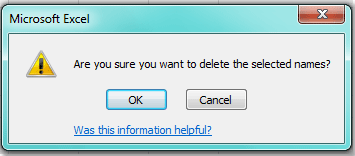
- Delete named range excel for mac vba how to#
- Delete named range excel for mac vba mod#
- Delete named range excel for mac vba code#
In this program, we declared R1, N1, V1 and rng1 as variables. MsgBox "Duplicate Rows Deleted: " & CStr (N1) If (Rng1.Columns(1), V1) > 1 ThenĪpplication.Calculation = xlCalculationAutomatic If (Rng1.Columns(1), vbNullString) > 1 Then Set Rng1 = Application.Intersect(ActiveSheet.UsedRange, _ ActiveSheet.Columns(ActiveCell.Column))Īpplication.StatusBar = "Processing Row: " & Format(Rng.Row, "#,#0")Īpplication.StatusBar = "Processing Row: " & Format(R1, "#,#0") Sub DeleteDuplicateRows6()Īpplication.Calculation = xlCalculationManual If that sounds like Latin, take a break and hop over to our Ultimate VBA course to learn more about this. The knowledge of member data and member functions is necessary to master this code. Note that you need to be familiar with the application objects, and its important functions and data members. Now we move on to a more complex program which takes large amount of data.
Delete named range excel for mac vba how to#
How to Delete Duplicate Rows Using VBA in Excel This process goes on till the last row of the selection is reached. When Y is equal to 3, the current row is deleted and Y is reset to 1. X and Y are incremented by 1 whenever, Y is not equal to 3. The ‘for’ loop goes from the value 1 to the total number of rows in the spreadsheet selection. Value 1 is assigned to both the variables. In this program, we declare two variables X and Y. Delete Every Third Row in a Worksheet Using VBA in Excel Sub DeleteRow5() will delete the row which has the del object. If the value is not equal to “Apple”, then the union function is used to unite del with cell_search. In this program we have assigned del as the cell object when the cell value is equal to “Apple”. We use the “for loop” to iterate through the cells. The intersect function returns the range object that is stored in the variable rng. ActiveSheet.UsedRange refers to the selected worksheet. Here Range(“A1:C20”), returns the selected range of cells. In this program, we declare three variables of data type Range. Set rng = Intersect(Range("A1:C20"), ActiveSheet.UsedRange) Delete Entire Rows Where the Cell Type is a String Sub DeleteRow4 ()ĭim rng As Range, cell_search As Range, del As Range We loop on this till the condition evaluates to false. If it’s completely divisible by three, that row is entirely deleted. In each loop, the value at cell with row number equal to lRow and Column 1 is divided by 3. Then we use the ‘Do While’ loop to iterate through the rows starting from row number 100 backwards to row number 1. In this program, we use the Dim keyword to declare the variable lRow, to refer to the last row.
Delete named range excel for mac vba mod#
If Cells(lRow,1) Mod 3 = 0 Then Rows(lRow).Delete Deleting Rows Based on Certain Condition Using Excel VBA Sub Next let’s move to more advanced programs using if conditional statement and loops. Rows(“10:20”) refers to the row range starting from row number 10 to 20.
Delete named range excel for mac vba code#
This code is written to delete multiple rows from row number 10 to 20. Deleting Multiple Rows Using Excel VBA Sub It has an associated function delete, which when executed deletes the relevant row completely. In this program, the 10th row is completely deleted from the active worksheet.

Deleting a specific row using Excel VBA Sub DeleteRow1() Now lets move on to the practical aspect of deleting rows in Excel. To execute the code press the F5 function key.

Alternatively, you can manually type in the code.


 0 kommentar(er)
0 kommentar(er)
